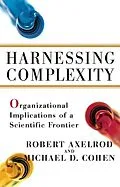Recent advances in the study of complexity have given scientists profound new insights into how natural innovation occurs and how its power can be exploited. Now two pioneers in the field, Robert Axelrod and Michael D. Cohen, provide leaders in business and government with a guide to complexity that will help them make effective decisions in a world of rapid change.
Building on evolutionary biology, computer science, and social design, Axelrod and Cohen have constructed a unique framework for improving the way people work together. Their approach to management is based on the concept of the Complex Adaptive System, which can describe everything from rain forests to the human gene pool, and from automated software agents to multinational companies. The authors' framework reveals three qualities that all kinds of managers must cultivate in their organization:
- Variation What is the best way to manage the development of software? Should the problem be broken up into small pieces for programmers working independently, thus enhancing variation, or should there be a centralized hierarchy of programmers ruled by a chain of command? The authors show how the decentralized creation of variation combined with the centralized maintenance of standards was the key to the success of the Linux "open source software" project, which brought together thousands of volunteers in cyberspace to produce an operating system that can outperform Microsoft's.
- Interaction Why did northern Italy prosper while southern Italy remained poor? Recognizing the internal interactions of a Complex Adaptive System -- be it a national region, a company, or a nonprofit group -- reveals vital networks of trust. Axelrod and Cohen explain that in successful adaptive systems, rich networks of horizontal linkages foster cooperation and provide an advantage over other less cooperatively networked groups. In the case of Italy, voluntary associations created networks of trust in the Middle Ages that became northern Italy's critical advantage over the south.
- Selection Is a Pulitzer Prize better than a National Book Award? How can foundations and corporations design competitions that have a positive effect on the evolution of excellence? The authors' framework makes clear that the worst selection processes are mired in orthodox standards that have not adapted to a new environment. The best selection processes, on the other hand, are created and run by leaders who understand how the standards they use can transform their organization and its environment.
This simple, paradigm-shifting analysis of how people work together will transform the way we think about getting things done in a group. Harnessing Complexity is the essential guide to creating wealth, power, and knowledge in the 21st century.
Autorentext
Robert Axelrod is Professor of Political Science and Public Policy at the University of Michigan. The author of The Evolution of Cooperation. He lives in Ann Arbor, Michigan.
Inhalt
Preface
I. Introduction
Introduction to the Framework
The Difficulty of Prediction
Complexity Research
The Design of Organizations and Strategies
The Information Revolution
Complexity and Information
Adaptation and Information
Complexity as a Way of Thinking
II. Variation
The Role of Variation
Altering the Frequency of Types
Copying With Error
Endogenous Copying Mechanisms
Recombining Mechanisms
Exploration Versus Exploitation
Example: Military Personnel Systems
Whether to Encourage Variety
Example: Linux Software Development
Extinction -- The Vanishing of Types
III. Interaction
The Importance of Interaction
Example: Social Capital
How Interaction Works
Proximity and Activation
Spaces: Physical and Conceptual
Example: Combating the AIDS Virus, Part 1
External Methods of Changing Interaction Patterns
Barriers to Movement in Time and Physical Space
Barriers to Movement in Conceptual Spaces
Semi-permeable Barriers
Example: Combating the AIDS Virus, Part 2
Activation in Sequence or in Parallel
Internal Methods of Changing Interaction Patterns
Following Another Agent
Following a Signal
Example: Tags in the Prisoner's Dilemma
Forming Boundaries
Separating Time Scales
Redistributing Stress
Example: Modes of Failure in Information Systems
Organizing Routines
Restructuring of Physical and Conceptual Spaces
IV. Selection
Defining Criteria of Success
Example: Prize Competitions
Determining the Level of Selection
Selection of Agents
Selection of Strategies
Attributing Credit for Success and Failure
Example: Military Simulation
Creating New Agents or Strategies
The Key Role of Copying
Detailed Differences Among Generic Copying Processes
Exercising Visible Leadership
V. Conclusion
The Central Elements of the Framework
How the Elements Form a Coherent Framework
What a User of the Framework Asks
What a User of the Framework Can Do
What May Come of This Approach
References
Index
